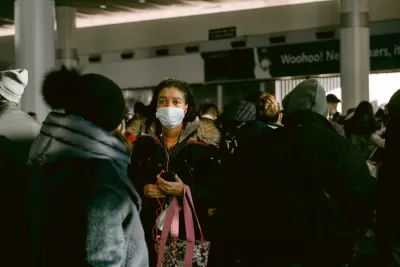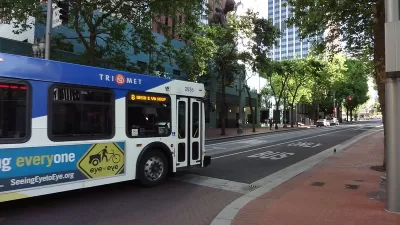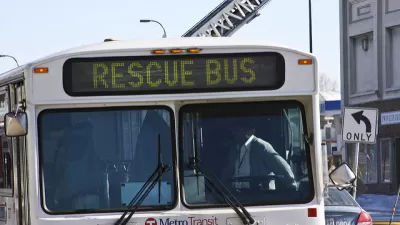In statements that echo the alarm of March 2020, transit officials in Los Angeles and Washington, D.C. recently announced plans to reduce transit service.

With every passing month, the continued operation of public transit systems in the United States looks more like a pilot project than a long-term feature of the transportation system. The transit systems of the pre-pandemic United States, paltry and inadequate as they might have been, might never return.
Repeated infusions of cash from the Infrastructure Investment and Jobs Act, approved in November 2021 and multiple pandemic relief packages (i.e., the CARES Act, approved in March 2020; the COVID-19 Emergency Relief Act of 2020, approved in December 2020; and the American Rescue Plan, approved in March 2021) haven't been enough to eliminate the threats bearing down on transit agencies. Depressed ridership numbers, reduced revenues, and driver shortages all still threaten to overwhelm any chance of recovery for public transit.
Two recent examples showcase the ongoing challenges.
The Los Angeles County Metropolitan Transportation Authority (L.A. Metro) recently announced plans to cut scheduled bus service by 12 percent starting on February 20, according to a February 1 article by Ryan Fonseca for LAist. The announcements of the reduced service came just a few days after Metro announced a $1.24 billion grant of American Rescue Plan funds for the maintenance and operation of service. With or without the $1.4 billion, L.A. Metro is short 550 bus drivers, and any rider (including this author) relying on the system in recent months can attest that service has suffered. L.A. Metro reports on trip cancellations every month, most recently calculating that 17.7 percent of total bus trips were cancelled in January, up from 10.8% in December. The 754, which runs along the busy Vermont Avenue corridor as one of the system's few remaining rapid routes, cancelled 50% of its trips in January. Viewed charitably, the planned service reductions are bringing the planned system closer in line with reality.
According to Fonseca, L.A. Metro plans to roll out the service cuts, relying on the tiered system of headway frequency implemented by the NextGen system redesign. The new frequencies on bus routes will be as follows:
- Tier 1 service frequency: 5-15 minutes weekday; 7.5-20 minutes weekend
- Tier 2 service frequency: 12-20 minutes weekday; 15-40 minutes weekend
- Tier 3 service frequency: 20-45 minutes weekday; 30-60 minutes weekend
- Tier 4 service frequency: 40-60 minutes weekday and weekend
Train service will also be reduced, according to Fonseca:
- The B (Red) and D (Purple) lines will run every 15 minutes at peak service times and 15 minutes midday and weekends
- The A (Blue), C (Green), E (Expo) and L (Gold) lines will run every 10 minutes during peak service times
Then there's Washington, D.C., where transit officials, given the lack of D.C. statehood, are compelled to report to Congress on the state of the transit system. At a hearing of the Oversight subcommittee on government operations, Washington Metropolitan Area Transit Authority (D.C. Metro) General Manager Paul J. Wiedefield announced that pre-pandemic transit service would not be coming back.
An article by Justin George for the Washington Post details the revelations of the hearing, putting the news in context of the ongoing challenges facing the transit system.
"Metro leaders are scrambling to find solutions for a $500 million shortfall beginning next summer, stemming from lost fares as riders gave up transit during the pandemic. Many office workers have opted to telework, including the federal workforce that made up 40 percent of the system’s rush-hour customers before the pandemic," writes George.
D.C. Metro officials anticipate having to face a budget shortfall exacerbated by years of maintenance issues, pandemic ridership declines, and driver shortages, when the finite amount of federal support provided during the pandemic, $1 billion, runs out in 2023 and 2024.
The financial risks facing transit agencies was one of the earliest signs of the pandemic's potential to upend life in U.S. communities, and one of the most obvious and urgent concerns for planners trying to assess the pandemic's effects. While federal funding has kept many systems afloat—much more than seemed possible in early March 2020—the full consequences of the emergency have only been delayed. System capacity has declined right along with ridership—neither of which are likely to return to pre-pandemic levels given the current politics of transportation and land use planning in the United States. Drivers and operators are in short supply, and neither are likely to become suddenly abundant given the current politics of public sector compensation.
Something's got to give. It's a question of when, not if.

Trump Administration Could Effectively End Housing Voucher Program
Federal officials are eyeing major cuts to the Section 8 program that helps millions of low-income households pay rent.

Planetizen Federal Action Tracker
A weekly monitor of how Trump’s orders and actions are impacting planners and planning in America.

Ken Jennings Launches Transit Web Series
The Jeopardy champ wants you to ride public transit.

Washington Legislature Passes Rent Increase Cap
A bill that caps rent increases at 7 percent plus inflation is headed to the governor’s desk.

From Planning to Action: How LA County Is Rethinking Climate Resilience
Chief Sustainability Officer Rita Kampalath outlines the County’s shift from planning to implementation in its climate resilience efforts, emphasizing cross-departmental coordination, updated recovery strategies, and the need for flexible funding.

New Mexico Aging Department Commits to Helping Seniors Age ‘In Place’ and ‘Autonomously’ in New Draft Plan
As New Mexico’s population of seniors continues to grow, the state’s aging department is proposing expanded initiatives to help seniors maintain their autonomy while also supporting family caregivers.
Urban Design for Planners 1: Software Tools
This six-course series explores essential urban design concepts using open source software and equips planners with the tools they need to participate fully in the urban design process.
Planning for Universal Design
Learn the tools for implementing Universal Design in planning regulations.
Heyer Gruel & Associates PA
Ada County Highway District
Institute for Housing and Urban Development Studies (IHS)
City of Grandview
Harvard GSD Executive Education
Toledo-Lucas County Plan Commissions
Salt Lake City
NYU Wagner Graduate School of Public Service






























